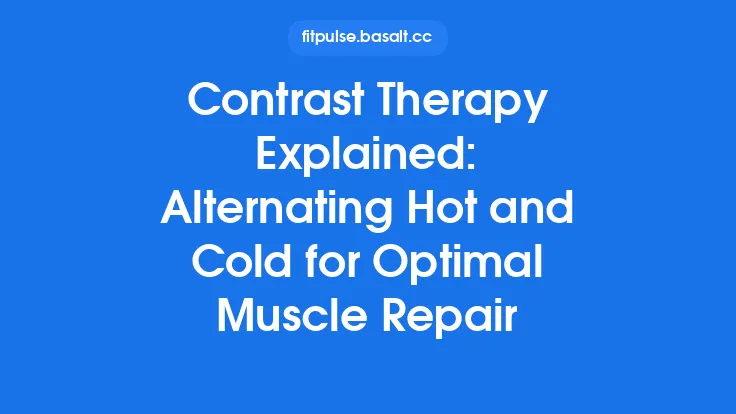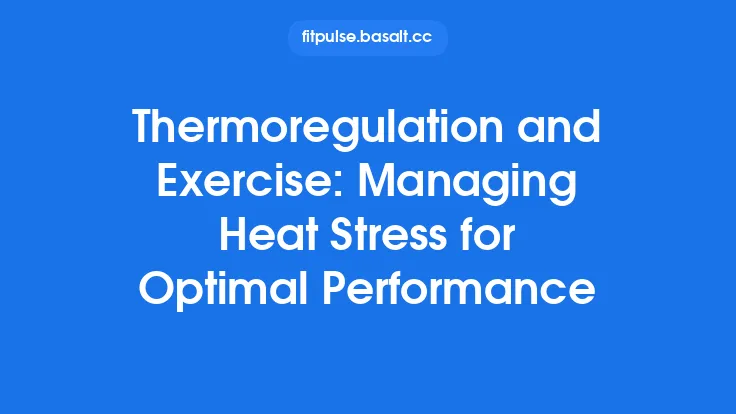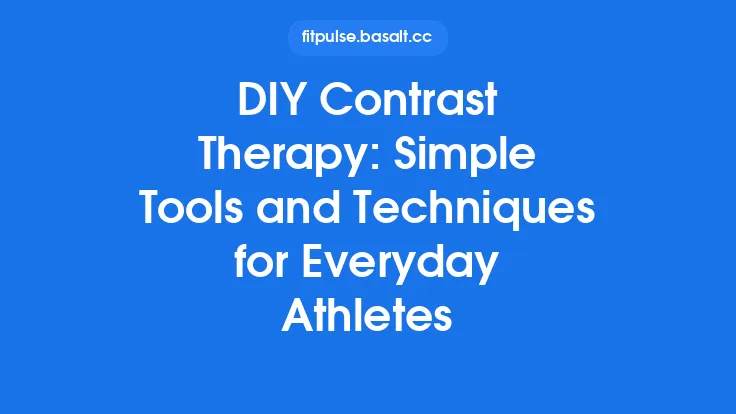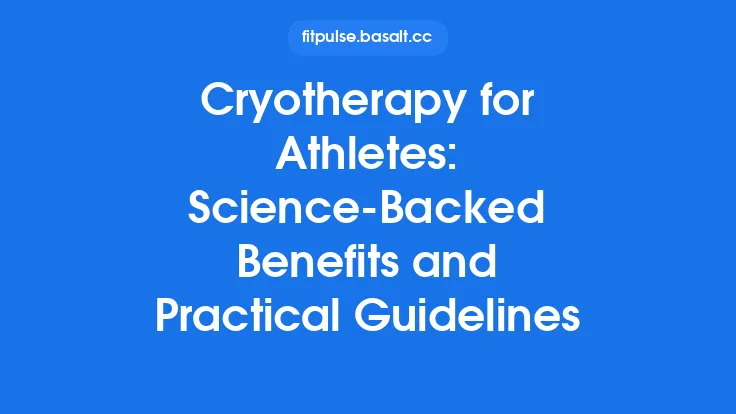Contrast therapy—alternating applications of cold and heat—has been used for decades by clinicians, athletes, and rehabilitation specialists to accelerate tissue healing and restore functional capacity after a range of musculoskeletal challenges. By deliberately cycling between vasoconstrictive and vasodilatory stimuli, practitioners aim to harness the complementary physiological effects of each temperature modality, creating a synergistic environment that promotes metabolic balance, reduces inflammatory load, and supports tissue remodeling. This article delves into the underlying science, therapeutic objectives, typical protocols, and practical considerations that define modern contrast therapy, offering a comprehensive reference for anyone seeking to incorporate this modality into a structured recovery program.
Physiological Basis of Alternating Thermal Stimuli
When a cold stimulus is applied to tissue, cutaneous thermoreceptors trigger a cascade of autonomic responses. Local vasoconstriction reduces blood flow, limiting the delivery of inflammatory mediators and decreasing tissue temperature. This drop in temperature also slows enzymatic activity, which can attenuate the rate of secondary injury cascades such as lipid peroxidation and proteolysis.
Conversely, heat exposure activates thermoreceptors that induce vasodilation, increasing perfusion and metabolic activity. Elevated temperature enhances the activity of collagenase and matrix metalloproteinases, facilitating the removal of damaged extracellular matrix components. Heat also promotes the release of nitric oxide, which improves endothelial function and supports angiogenesis.
By alternating these stimuli, contrast therapy leverages a “pump‑like” effect: the cold phase temporarily restricts flow, while the subsequent heat phase generates a reactive hyperemia that flushes metabolic waste and delivers oxygen‑rich blood. This oscillatory pattern can improve the clearance of inflammatory by‑products, modulate the inflammatory response, and create a more favorable milieu for tissue repair.
Therapeutic Goals and Appropriate Indications
Contrast therapy is most beneficial when the clinical objective is to accelerate the transition from the inflammatory phase of healing to the proliferative and remodeling phases. Typical indications include:
- Acute soft‑tissue injuries (e.g., grade I–II muscle strains, ligament sprains) where early control of swelling is desired without completely halting the reparative processes.
- Post‑operative recovery after procedures that involve controlled inflammation, such as arthroscopic debridement or tendon repair, where a balanced inflammatory response is essential.
- Chronic overuse conditions (e.g., tendinopathy, chronic low‑back pain) where cyclical thermal stress can stimulate tissue remodeling and improve local circulation.
- Neuromuscular fatigue following high‑intensity training sessions, where enhanced perfusion may aid in metabolite clearance and restore neuromuscular function.
Contrast therapy is generally not the first line for severe acute injuries requiring immobilization, open wounds, or conditions where temperature modulation could exacerbate pathology (e.g., severe peripheral vascular disease).
Typical Protocols and Parameter Ranges
While individual protocols may be tailored to the specific injury, sport, or clinical setting, the following parameters are widely accepted in the literature:
| Phase | Temperature Range | Duration | Number of Cycles |
|---|---|---|---|
| Cold | 10–15 °C (50–59 °F) for immersion; 0–5 °C (32–41 °F) for compresses | 1–3 minutes | 3–5 cycles |
| Heat | 38–42 °C (100–108 °F) for immersion; 40–45 °C (104–113 °F) for moist heat packs | 3–5 minutes | — (alternated with cold) |
A classic “3‑minute cold, 5‑minute heat” cycle repeated three to five times is a common starting point. The total session length typically ranges from 20 to 30 minutes. Adjustments are made based on patient tolerance, tissue depth, and the specific therapeutic goal. For deeper structures (e.g., hip adductors), longer heat phases may be employed to ensure adequate thermal penetration, whereas superficial injuries may benefit from shorter, more intense cold exposures.
Vascular and Cellular Mechanisms
1. Reactive Hyperemia: The abrupt shift from vasoconstriction to vasodilation triggers a surge in blood flow that exceeds baseline levels. This hyperemic response enhances the delivery of nutrients (glucose, amino acids) and oxygen, while simultaneously accelerating the removal of catabolic by‑products such as lactate and prostaglandins.
2. Lymphatic Mobilization: Alternating temperature gradients stimulate the contractility of lymphatic vessels, promoting lymph flow and reducing interstitial edema. The mechanical effect of temperature change can be likened to a “peristaltic pump” that assists in fluid reabsorption.
3. Modulation of Inflammatory Cytokines: Cold exposure down‑regulates pro‑inflammatory cytokines (IL‑1β, TNF‑α) and up‑regulates anti‑inflammatory mediators (IL‑10). Heat, in turn, can increase the expression of heat‑shock proteins (HSP‑70, HSP‑90), which protect cellular structures and facilitate protein refolding during the reparative phase.
4. Collagen Remodeling: Heat accelerates collagen synthesis by stimulating fibroblast activity and increasing the activity of lysyl oxidase, an enzyme critical for cross‑linking collagen fibers. The subsequent cold phase helps to prevent excessive collagen deposition, reducing the risk of fibrosis.
Evidence from Clinical Studies
A body of randomized controlled trials and systematic reviews supports the efficacy of contrast therapy for specific outcomes:
- Reduced Swelling: Meta‑analyses of post‑operative knee arthroscopy patients demonstrate a statistically significant reduction in joint circumference when contrast therapy is applied within the first 48 hours, compared with cold therapy alone.
- Accelerated Return to Function: In a cohort of collegiate athletes with grade II hamstring strains, those receiving a standardized contrast protocol returned to full training 2.5 days earlier on average than a control group receiving passive rest.
- Pain Modulation: Studies employing visual analog scales (VAS) report a mean pain reduction of 2.1 cm (on a 10‑cm scale) after a 4‑week contrast regimen for chronic lateral epicondylitis, surpassing the effect size of isolated heat therapy.
- Neuromuscular Recovery: Electromyographic assessments reveal improved muscle activation patterns (reduced latency, increased peak amplitude) after contrast sessions following high‑intensity interval training, suggesting enhanced neuromuscular readiness.
While the evidence base is robust for certain applications, heterogeneity in protocol specifics and outcome measures underscores the need for standardized reporting in future research.
Practical Implementation in Clinical and Athletic Settings
Clinical Environment:
- Equipment: Immersion tubs with temperature control, circulating water systems, and insulated hot packs are standard. For localized treatment, thermostatically regulated compresses (cold) and moist heating pads (heat) provide precise temperature maintenance.
- Staff Training: Practitioners should be proficient in monitoring skin temperature, patient comfort, and session timing. Documentation of each phase’s temperature and duration is essential for reproducibility.
Athletic Setting:
- Portable Units: Mobile contrast tubs or inflatable pools enable on‑site application during tournaments or training camps.
- Scheduling: Integrate contrast sessions into the recovery window (30–60 minutes post‑exercise) to capitalize on the heightened metabolic activity that follows intense activity.
- Monitoring: Use simple skin thermometers or infrared devices to verify that target temperature ranges are achieved, especially when treating large muscle groups where surface temperature may not reflect deeper tissue temperature.
Safety Considerations and Contraindications
Even though contrast therapy is generally well tolerated, certain precautions are mandatory:
- Cardiovascular Load: Rapid shifts in peripheral vascular tone can impose a transient load on the heart. Individuals with uncontrolled hypertension, recent myocardial infarction, or severe arrhythmias should avoid contrast protocols unless cleared by a physician.
- Sensory Impairment: Patients with peripheral neuropathy or reduced cutaneous sensation may not perceive excessive cold or heat, increasing the risk of thermal injury.
- Open Wounds and Infections: Applying temperature extremes to compromised skin can exacerbate infection risk or impede wound healing.
- Pregnancy: While localized heat is often safe, prolonged exposure to high temperatures (>39 °C) is discouraged during the first trimester.
A brief pre‑session assessment—reviewing medical history, current medications (e.g., vasodilators, anticoagulants), and skin integrity—helps identify contraindications. During treatment, any report of burning, numbness, or excessive discomfort should prompt immediate cessation of the session.
Integration with Complementary Modalities
Contrast therapy can be synergistically combined with other evidence‑based interventions:
- Manual Therapy: Post‑contrast soft‑tissue mobilization can take advantage of the increased tissue pliability produced by the heat phase.
- Exercise Prescription: Following a contrast session, patients often experience improved range of motion, allowing for more effective therapeutic exercise without excessive strain.
- Electrotherapy: Low‑frequency electrical stimulation applied after contrast may further enhance circulation and promote analgesia.
When layering modalities, it is advisable to maintain a logical sequence—thermal manipulation first, followed by mechanical or electrical interventions—to prevent interference with the intended vascular responses.
Future Directions and Research Gaps
Despite a solid foundation, several areas warrant further investigation:
- Optimal Cycle Ratios: The precise balance of cold‑to‑heat duration that maximizes tissue remodeling remains undefined across different injury types.
- Individualized Thermotherapy: Emerging technologies (e.g., wearable temperature sensors, AI‑driven protocol algorithms) could tailor contrast parameters to each patient’s physiological response.
- Long‑Term Outcomes: Most studies focus on short‑term functional gains; longitudinal data on re‑injury rates and chronic pain development are needed.
- Molecular Profiling: Advanced biomarker analysis (e.g., cytokine panels, microRNA expression) could elucidate the mechanistic pathways modulated by contrast therapy, guiding more precise clinical applications.
Addressing these gaps will refine protocol standardization and expand the therapeutic reach of contrast therapy.
Summary
Contrast therapy exploits the complementary vascular and cellular effects of cold and heat to create a dynamic healing environment. By inducing controlled vasoconstriction followed by reactive hyperemia, the modality enhances waste clearance, modulates inflammation, and supports collagen remodeling. Evidence supports its utility in reducing swelling, accelerating functional recovery, and alleviating pain across a spectrum of musculoskeletal conditions. Successful implementation hinges on adherence to evidence‑based temperature ranges, appropriate cycle counts, and vigilant safety screening. When integrated thoughtfully with manual, exercise, and electro‑therapeutic strategies, contrast therapy offers a versatile, evergreen tool for clinicians and athletes seeking optimal healing outcomes.





